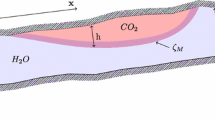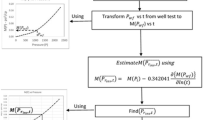Abstract
Carbon dioxide (CO2) has been injected in the subsurface permeable formations as a means to cut atmospheric CO2 emissions and/or enhance oil recovery (EOR). It is important to constrain the boundaries of the CO2 plume in the target formation and/or other formations hosting the CO2 migrated from the target formation. Monitoring methods and technologies to assess the CO2 plume boundaries over time within a reservoir of interest are required. Previously introduced methods and technologies on pressure monitoring to detect the extent of the CO2 plume require at least two wells, i.e. pulser and observation wells. We introduce pressure transient technique requiring single well only. Single well pressure transient testing (drawdown/buildup/injection/falloff) is widely used to determine reservoir properties and wellbore conditions. Pressure diagnostic plots are used to identify different flow regimes and determine the reservoir/well characteristics. We propose a method to determine the plume extent for a constant rate pressure transient test at a single well outside the CO2 plume. Due to the significant contrast between mobility and storativity of the CO2 and native fluids (oil or brine), the CO2 boundary causes deviation in the pressure diagnostic response from that corresponding to previously identified heterogeneities. Using the superposition principle, we develop a relationship between the deviation time and the plume boundary. We demonstrate the applicability of the proposed method using numerically generated synthetic data corresponding to homogeneous, heterogeneous, and anisotropic cases to evaluate its potential and limitations. We discuss ways to identify and overcome the potential limitations for application of the method in the field.










Similar content being viewed by others
References
Abbaszadeh M, Hegeman PS (1990) Pressure-transient analysis for a slanted well in a reservoir with vertical pressure support. SPE Form Eval. https://doi.org/10.2118/19045-PA
Agarwal RG (1980) A new method to account for producing time effects when drawdown type curves are used to analyze pressure buildup and other test data. Society of Petroleum Engineers, Dallas
Bourdet D (2002) Well test analysis: the use of advanced interpretation models. Elsevier, Amsterdam
Chen CC, Chu W-C, Sadighi S (1996) Pressure-transient testing of gas reservoirs with edge-waterdrive. SPE Form Eval. https://doi.org/10.2118/28381-PA
CMG-GEM (2015) Computer modelling group CMG-GEM version 2015 user’s guide. Computer Modelling Group Ltd., Calgary
Corey AT (1954) The interrelation between gas and oil relative permeabilities. Prod Mon 19:38–41
Haghighat SA, Mohaghegh SD, Gholami V, Shahkarami A (2013) Pressure history matching for CO2 storage in saline aquifers: case study for Citronelle Dome. In: Carbon management technology conference, Alexandria
Hosseini SA, Alfi M (2016) Time-lapse application of pressure transient analysis for monitoring compressible fluid leakage. Greenh Gases Sci Technol 6:352–369. https://doi.org/10.1002/ghg.1570
Hu L (2017) Characterization of CO2 plumes in deep saline formations using fluid pressure tomography
Hu LW, Bayer P, Alt-Epping P, Tatomir A, Sauter M, Brauchler R (2015) Time-lapse pressure tomography for characterizing CO2 plume evolution in a deep saline aquifer. Int J Greenh Gas Control 39:91–106. https://doi.org/10.1016/j.ijggc.2015.04.013
Hu L, Bayer P, Brauchler R (2016) Detection of carbon dioxide leakage during injection in deep saline formations by pressure tomography. Water Resour Res
Hu L, Doetsch J, Brauchler R, Bayer P (2017) Characterizing CO2 plumes in deep saline formations: comparison and joint evaluation of time-lapse pressure and seismic tomography. Geophysics 82:ID1–ID18
Johnson CR, Greenkorn RA, Woods EG (1966) Pulse-testing: a new method for describing reservoir flow properties between wells. J Pet Trans
Koperna GJ (2013) Anthropogenic test simulation results joint Citronelle–Cranfield. In: SECARB technical meeting, Austin
Lee J, Rollins JB, Spivey JP (2003) Pressure transient testing. In: SPE textbook series, vol 9. Society of Petroleum Engineers, Dallas
Petrusak RL, Cyphers S, Bumgardner SB, Hills D, Pashin J, Esposito RA (2010) Saline reservoir storage in an active oil field: extracting maximum value from existing data for initial site characterization; Southeast Regional Carbon Sequestration Partnership (SECARB) phase III. In: SPE paper 139700, SPE international conference on CO2 capture, storage, and utilization, New Orleans
Shakiba M, Hosseini SA (2016) Detection and characterization of CO2 leakage by multi-well pulse testing and diffusivity tomography maps. Int J Greenh Gas Control 54:15–28. https://doi.org/10.1016/j.ijggc.2016.08.015
Shepard D (1968) A two-dimensional interpolation function for irregularly-spaced data. In: Proceedings of the 1968 23rd ACM national conference. ACM, New York, pp 517–524
Spivey JP, Lee WJ (2013) Applied well test interpretation. In: SPE textbook series. SPE, Dallas
Streltsova-Adams TD (1979) Pressure drawdown in a well with limited flow entry. J Pet Tech. https://doi.org/10.2118/7486-PA
Sun AY, Lu JM, Hovorka S (2015) A harmonic pulse testing method for leakage detection in deep subsurface storage formations. Water Resour Res 51:4263–4281. https://doi.org/10.1002/2014wr016567
Sun AY, Lu J, Freifeld BM, Hovorka SD, Islam A (2016) Using pulse testing for leakage detection in carbon storage reservoirs: a field demonstration. Int J Greenh Gas Control 46:215–227. https://doi.org/10.1016/j.ijggc.2016.01.015
Tran NH, Zeidouni M (2017) CO2 plume characterization using pressure arrival time. Society of Petroleum Engineers, Dallas
van Genuchten MT (1980) A closed-form equation for predicting the hydraulic conductivity of unsaturated soils. Soil Sci Soc Am J 44:892–898
Zeidouni M, Hovorka SD, Shi K (2016) Tracer test to constrain CO2 residual trapping and plume evolution. Environ Earth Sci 75:1451. https://doi.org/10.1007/s12665-016-6261-6
Zeidouni M, Tran NH, Munawar MD (2017) Interpretation of above-zone pressure influence time to characterize CO2 leakage. Greenh Gases Sci Technol 7(6):1050–1064
Acknowledgements
The authors would like to thank the funding from Louisiana State University, College of Engineering—Chevron Innovative Research Fund (CIRS) 2016. We also appreciate the funding from the U.S. Department of Energy, National Energy Technology Laboratory (NETL) under Grant number DE-FE0029274. The authors are thankful to the two anonymous reviewers for their thoughtful and constructive comments.
Author information
Authors and Affiliations
Corresponding author
Rights and permissions
About this article
Cite this article
Tran, N., Zeidouni, M. Pressure transient technique to constrain CO2 plume boundaries. Environ Earth Sci 77, 736 (2018). https://doi.org/10.1007/s12665-018-7926-0
Received:
Accepted:
Published:
DOI: https://doi.org/10.1007/s12665-018-7926-0




